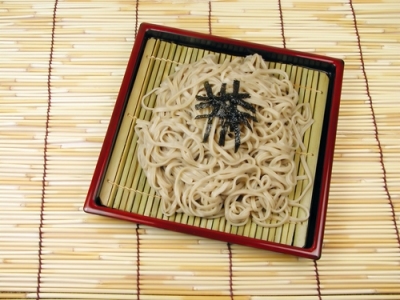The chilled soba arrives on a lacquer and bamboo box ? the bamboo sitting atop the lacquer. Soba was originally cooked by placing the noodles on bamboo slats and steaming it. It?s no longer cooked that way, but the tradition of serving it on the bamboo remains.
Many restaurants in Japan vary their menus to match the season, and soba shops are no different. One example of this is gardenia-infused soba. When it arrives, the gardenia soba turns out to be yellow and very smooth to both the eye and the tongue. It does not taste much different than regular sarashina soba. Soba itself does not have much of a taste, somewhat like pasta. However, in its pure form, it does have a wheat-y taste, but it still generally picks up the taste of the broth, if eaten in a hot bowl of soup, or the dipping sauce, if eaten cold. Indeed, the soup of the hot soba is strong and flavorful, designed originally in the Edo period to warm the workers of Tokyo and keep them strong and healthy to continue their service to their city.
This may be where the tradition of slurping first arrived – the broth of the soba is served steaming hot – too hot for comfortable eating for most people. The quick, practiced slurps help people cool the noodles as they enter their mouths and then also help them avoid having to bite the noodle. The sound comes from the sound of the air passing through the mouth to cool the noodle; thus, the noisier the better.
 One specialty type of soba is tororo soba, or yam soba, and it is quite a different story. Before the soba arrives, the yam comes in a lacquer bowl with dried nori, or seaweed on top of it. The yam is thick – coarser than oatmeal that’s been left out too long. Added to the bowl is the requisite scallions, and sauce. On the side is a tiny little bowl containing one quail egg, already broken into the bowl. Diners pour the raw egg over the yam mixture and stir it all together with chopsticks.
One specialty type of soba is tororo soba, or yam soba, and it is quite a different story. Before the soba arrives, the yam comes in a lacquer bowl with dried nori, or seaweed on top of it. The yam is thick – coarser than oatmeal that’s been left out too long. Added to the bowl is the requisite scallions, and sauce. On the side is a tiny little bowl containing one quail egg, already broken into the bowl. Diners pour the raw egg over the yam mixture and stir it all together with chopsticks.
The tororo soba does not come with the same sarashina soba but the brown type, called mori soba. The difference between the two is distinctive. The mori soba is much darker, made mostly from soba grown in Hokkaido and then ground into powder in the restaurant. From the powder, the chef then mixes in a small amount of wheat flour to bind it before rolling it and cutting it into the noodles. The mori, “Lets you enjoy soba’s distinctive flavor and aroma” . The mori soba goes better with the yam than the sarashina.